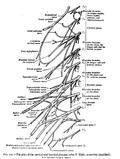Thoracic spinal nerve 1
Thoracic Spinal Nerve 1[edit]
The Thoracic Spinal Nerve 1, also known as T1, is one of the twelve pairs of spinal nerves that emerge from the thoracic region of the spinal cord. It is the first nerve in the thoracic spinal nerve series and plays a crucial role in the innervation of various structures in the upper body.
Anatomy[edit]
The T1 nerve arises from the spinal cord at the level of the first thoracic vertebra, which is located just below the seventh cervical vertebra (C7). It emerges from the intervertebral foramen, a small opening between adjacent vertebrae, along with the T1 spinal nerve root.
Once it exits the intervertebral foramen, the T1 nerve divides into multiple branches, which supply different structures in the upper body. These branches include the anterior and posterior branches.
The anterior branch of T1 innervates the intercostal muscles, which are responsible for the movement of the ribs during respiration. It also provides sensory innervation to the skin overlying the upper chest and part of the shoulder region.
The posterior branch of T1 supplies the deep muscles of the back, including the rhomboids and levator scapulae. It also provides sensory innervation to the skin overlying the upper back region.
Function[edit]
The T1 nerve is primarily responsible for motor and sensory functions in the upper body. The motor fibers of the T1 nerve control the movement of the intercostal muscles, allowing for the expansion and contraction of the ribcage during breathing. These muscles play a vital role in respiration and are essential for maintaining proper lung function.
The sensory fibers of the T1 nerve transmit sensory information from the skin overlying the upper chest, shoulder, and upper back regions. This includes sensations such as touch, temperature, and pain. The sensory information is then relayed to the brain, allowing for the perception and interpretation of these sensations.
Clinical Significance[edit]
Damage or dysfunction of the T1 nerve can lead to various symptoms and conditions. For example, injury to the T1 nerve can result in weakness or paralysis of the intercostal muscles, leading to difficulty in breathing and decreased lung function. This can significantly impact an individual's quality of life and may require medical intervention.
Additionally, damage to the sensory fibers of the T1 nerve can cause sensory disturbances in the upper chest, shoulder, and upper back regions. This may manifest as numbness, tingling, or pain in these areas. Identifying and treating the underlying cause of these symptoms is crucial for effective management.
Related Topics[edit]
References[edit]
1. Standring, S. (Ed.). (2016). Gray's Anatomy: The Anatomical Basis of Clinical Practice (41st ed.). Elsevier. 2. Drake, R. L., Vogl, W., & Mitchell, A. W. M. (2014). Gray's Anatomy for Students (3rd ed.). Elsevier.
-
Thoracic_spinal_nerve_1
-
Thoracic_spinal_nerve_1
-
Thoracic_spinal_nerve_1
Ad. Transform your life with W8MD's Budget GLP-1 injections from $75


W8MD offers a medical weight loss program to lose weight in Philadelphia. Our physician-supervised medical weight loss provides:
- Weight loss injections in NYC (generic and brand names):
- Zepbound / Mounjaro, Wegovy / Ozempic, Saxenda
- Most insurances accepted or discounted self-pay rates. We will obtain insurance prior authorizations if needed.
- Generic GLP1 weight loss injections from $75 for the starting dose.
- Also offer prescription weight loss medications including Phentermine, Qsymia, Diethylpropion, Contrave etc.
NYC weight loss doctor appointmentsNYC weight loss doctor appointments
Start your NYC weight loss journey today at our NYC medical weight loss and Philadelphia medical weight loss clinics.
- Call 718-946-5500 to lose weight in NYC or for medical weight loss in Philadelphia 215-676-2334.
- Tags:NYC medical weight loss, Philadelphia lose weight Zepbound NYC, Budget GLP1 weight loss injections, Wegovy Philadelphia, Wegovy NYC, Philadelphia medical weight loss, Brookly weight loss and Wegovy NYC
|
WikiMD's Wellness Encyclopedia |
| Let Food Be Thy Medicine Medicine Thy Food - Hippocrates |
Medical Disclaimer: WikiMD is not a substitute for professional medical advice. The information on WikiMD is provided as an information resource only, may be incorrect, outdated or misleading, and is not to be used or relied on for any diagnostic or treatment purposes. Please consult your health care provider before making any healthcare decisions or for guidance about a specific medical condition. WikiMD expressly disclaims responsibility, and shall have no liability, for any damages, loss, injury, or liability whatsoever suffered as a result of your reliance on the information contained in this site. By visiting this site you agree to the foregoing terms and conditions, which may from time to time be changed or supplemented by WikiMD. If you do not agree to the foregoing terms and conditions, you should not enter or use this site. See full disclaimer.
Credits:Most images are courtesy of Wikimedia commons, and templates, categories Wikipedia, licensed under CC BY SA or similar.
Translate this page: - East Asian
中文,
日本,
한국어,
South Asian
हिन्दी,
தமிழ்,
తెలుగు,
Urdu,
ಕನ್ನಡ,
Southeast Asian
Indonesian,
Vietnamese,
Thai,
မြန်မာဘာသာ,
বাংলা
European
español,
Deutsch,
français,
Greek,
português do Brasil,
polski,
română,
русский,
Nederlands,
norsk,
svenska,
suomi,
Italian
Middle Eastern & African
عربى,
Turkish,
Persian,
Hebrew,
Afrikaans,
isiZulu,
Kiswahili,
Other
Bulgarian,
Hungarian,
Czech,
Swedish,
മലയാളം,
मराठी,
ਪੰਜਾਬੀ,
ગુજરાતી,
Portuguese,
Ukrainian


